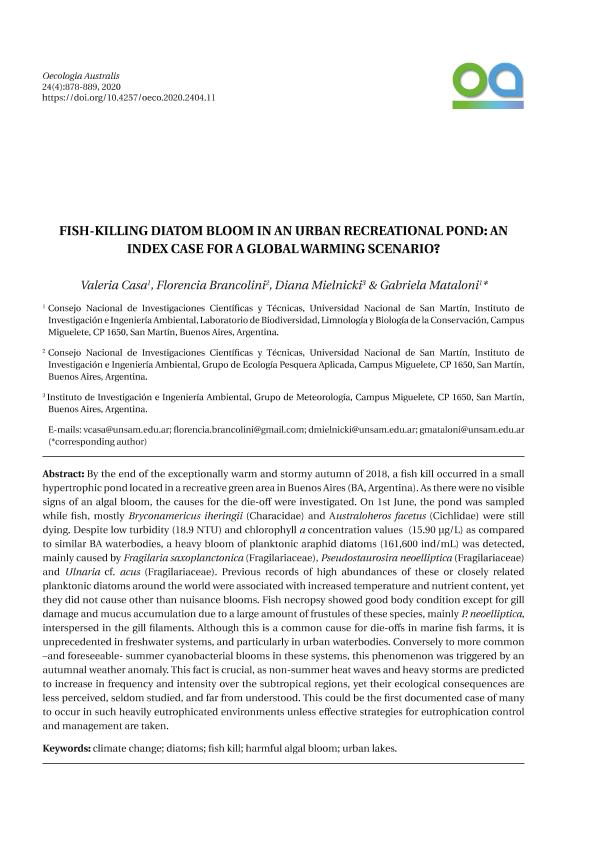Artículo
Fish-killing diatom bloom in an urban recreational pond: An index case for a global warming scenario?
Fecha de publicación:
08/2020
Editorial:
Universidade Federal do Rio de Janeiro
Revista:
Oecologia Australis
ISSN:
2177-6199
Idioma:
Inglés
Tipo de recurso:
Artículo publicado
Clasificación temática:
Resumen
By the end of the exceptionally warm and stormy autumn of 2018, a fish kill occurred in a small hypertrophic pond located in a recreative green area in Buenos Aires (BA, Argentina). As there were no visible signs of an algal bloom, the causes for the die-off were investigated. On 1st June, the pond was sampled while fish, mostly Bryconamericus iheringii (Characidae) and Australoheros facetus (Cichlidae) were still dying. Despite low turbidity (18.9 NTU) and chlorophyll a concentration values (15.90 µg/L) as compared to similar BA waterbodies, a heavy bloom of planktonic araphid diatoms (161,600 ind/mL) was detected, mainly caused by Fragilaria saxoplanctonica (Fragilariaceae), Pseudostaurosira neoelliptica (Fragilariaceae) and Ulnaria cf. acus (Fragilariaceae). Previous records of high abundances of these or closely related planktonic diatoms around the world were associated with increased temperature and nutrient content, yet they did not cause other than nuisance blooms. Fish necropsy showed good body condition except for gill damage and mucus accumulation due to a large amount of frustules of these species, mainly P. neoelliptica, interspersed in the gill filaments. Although this is a common cause for die-offs in marine fish farms, it is unprecedented in freshwater systems, and particularly in urban waterbodies. Conversely to more common –and foreseeable-summer cyanobacterial blooms in these systems, this phenomenon was triggered by an autumnal weather anomaly. This fact is crucial, as non-summer heat waves and heavy storms are predicted to increase in frequency and intensity over the subtropical regions, yet their ecological consequences are less perceived, seldom studied, and far from understood. This could be the first documented case of many to occur in such heavily eutrophicated environments unless effective strategies for eutrophication control and management are taken.
Palabras clave:
CLIMATE CHANGE
,
DIATOMS
,
FISH KILL
,
HARMFUL ALGAL BLOOM
,
URBAN LAKES
Archivos asociados
Licencia
Identificadores
Colecciones
Articulos (IIIA)
Articulos de INSTITUTO DE INVESTIGACION E INGENIERIA AMBIENTAL
Articulos de INSTITUTO DE INVESTIGACION E INGENIERIA AMBIENTAL
Citación
Casa, Valeria; Brancolini, Florencia; Mielnicki, Diana Matilde; Mataloni, Maria Gabriela; Fish-killing diatom bloom in an urban recreational pond: An index case for a global warming scenario?; Universidade Federal do Rio de Janeiro; Oecologia Australis; 24; 4; 8-2020; 878-889
Compartir
Altmétricas




